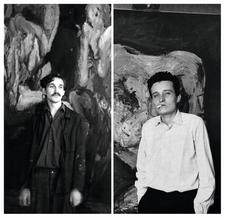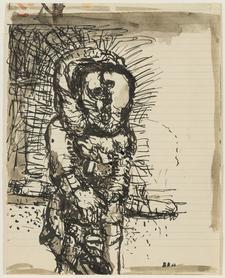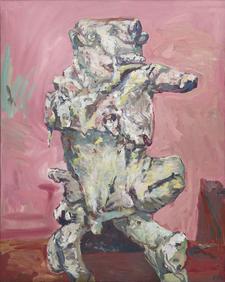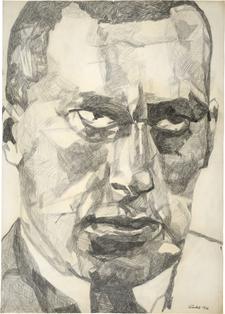
Kunstmuseum Schloss Derneburg is pleased to announce Self-taught: Baselitz/Schönebeck, 1962-66. Equally frustrated with the repression of a national consciousness at the time the Berlin Wall was being erected, this exhibition highlights Georg Baselitz and Eugen Schönebeck’s self-positioning as outsiders. Both artists questioned a complicated morality as newly isolated students in West Berlin, seeking influences on the fringe that would echo along drastically radical paths. Drawn from the Hall Collection, the exhibition presents approximately 30 works by Baselitz and Schönebeck completed in the immediate years following the dissolution of their friendship.
Schönebeck (b. 1936, Heidenau) and Baselitz (b. 1938, Deutschbaselitz) met in 1957, after independently immigrating from East Berlin to study at the Hochschule für Bildende Künste. Their shared Saxon background and an antagonism towards figuration/abstraction emboldened their interests in the École de Paris, the art of the mentally ill, and the writing of Antonin Artaud and Gottfried Benn. Their revered collaboration, Pandemonium I and II, was quickly followed by an end to their friendship, and in the years following, they pursued self-driven interests in approaches born outside of Germany. Amongst others, Baselitz was drawn to Italian mannerism and Russian symbolism, while Schönebeck was influenced by Mexican muralism and his Soviet training in the East. In 1966, Baselitz moved to rural Osthofen, and Schönebeck famously isolated from the art world, by which time both artists had developed a new type of hero at ideological extremes.
Baselitz’s drawing Ohne Titel (Die groβe Nacht im Eimer) (1962) is related to the painting of the same title. Inspired by the Irish poet Brendan Behan who performed his poems drunk in public while exposing himself, the painting was famously confiscated by police, leading to an obscenity charge.
Schönebeck’s painting Ginster (1963) presents a new form of man, existentially in disrepair and compiled of limbs and flesh that appear ripped apart and reassembled. The figure uncomfortably balances on a fallen cross, in front of a Saxon landscape distorted by a pink sky.
During his early years in West Berlin, Baselitz began closely studying Old Master paintings. In a series of Idol paintings, of which Das Idol (Der unbekannte Neijswestnij) (1964) is an example, the elongated neck of a towering figure mirrors Pontormo’s clean shaven St. Jerome, while the suggestion of a cross is surrounded by a deep red field.
The drawing Majakowski (1966) exemplifies Schönebeck’s large-scale compositions made in pencil, in which a portrait of the tragic Soviet literary figure is divided into geometric sections and dramatically contoured by cross hatching. The year marked a social-political critique of the portraits of cultural figures later identified as “heroes of the East” and pays homage to Schönebeck’s early education in East Germany.
For more information and images, please contact the Hall Art Foundation’s administrative office at info@hallartfoundation.org.
The exhibition is only accessible by guided tour.

Georg Baselitz and Eugen Schönebeck, independently photographed in their Berlin studios, 1962
Left photo: © Elke Baselitz 2024
Right Photo: Georg Baselitz © Georg Baselitz 2024

Georg Baselitz
Ohne Titel (Die groβe Nacht im Eimer) [Untitled (The Big Night down the Drain)], 1962
India ink, wash on lined paper
9-1/2 x 7-1/2 in. (24 x 19 cm)
Hall Collection. Courtesy Hall Art Foundation
© Georg Baselitz 2024

Eugen Schönebeck
Ginster [Broom], 1963
Oil on canvas
64 x 51 in. (162 x 129 cm)
Hall Collection. Courtesy Hall Art Foundation
© VG Bild-Kunst, Bonn

Georg Baselitz
Das Idol (Der unbekannte Neijswestnij) [The Idol (The unknown Neizvestny)], 1964
Oil on canvas
39-1/2 x 32 in. (100 x 82 cm)
Hall Collection. Courtesy Hall Art Foundation
© Georg Baselitz 2024

Eugen Schönebeck
Majakowski (Mayakovsky), 1966
Graphite on paper
33-3/4 x 24 in. (85.5 x 61 cm)
Hall Collection. Courtesy Hall Art Foundation
© VG Bild-Kunst, Bonn